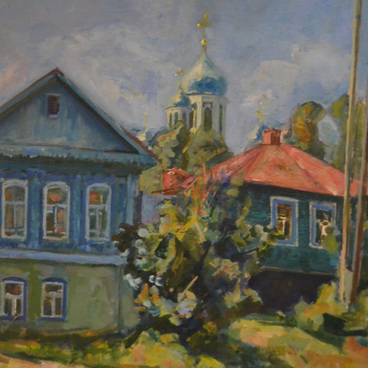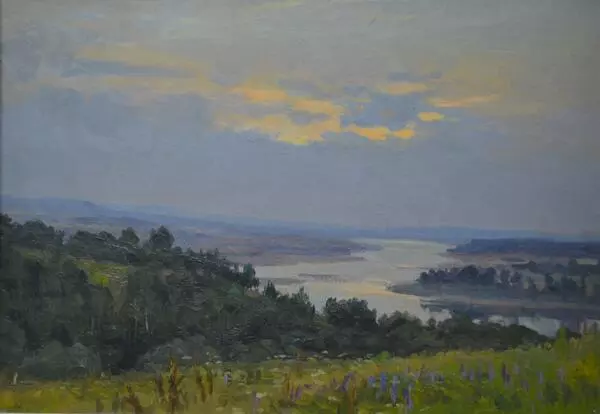The artist Alexey Pisarev was born in 1909 in Voronezh. There he studied at an art-industrial technical school, in a workshop under the guidance of Alexander Buchkuri, an original painter, a student of Ilya Repin. After that, Pisarev moved to Moscow and entered the Moscow Art College, and then at the refresher courses for artists at the Moscow Art Institute. He was taught by professionals of Soviet painting and graphics: Boris Ioganson, Konstantin Istomin and Alexander Moravov.
When the Great Patriotic War began, Pisarev volunteered for the frontline duty. He was the captain of the mine-sapper service and received the Order of the Red Star and the Medal ‘For Courage’.
The artist returned home in 1945 and devoted himself to painting. He worked in different techniques, but preferred oil painting. Landscape was his favorite genre. Pisarev participated in exhibitions of the Moscow Union of Artists and executed two large-format canvases for the Museum of Earth Science under the Moscow State University. His works are kept in the Tretyakov Gallery, State Historical Museum, Museum of History and Reconstruction of Moscow, as well as in private collections around the world.
Pisarev combined his creative activity with social work: he was chairman of the board of the Moscow branch of the Art Fund of the RSFSR, and deputy chairman of the board of the Union of Artists, Moscow Branch.
In the painting ‘Early Spring’, Pisarev depicted the nature of his native places — a typical Central Russian landscape: a river bank, a meadow, a forest that wakes up after winter. The artist seemed to have saturated the canvas with moisture — a river that has just freed itself from ice, snow that is melting, low clouds — these elements created a feeling of fresh, moist spring air. With the help of highlights on rivers and on the ground, the painter subtly conveys the play of light in the sky.
Pisarev used the effect of depth — he combined muted colors in the foreground with bright, saturated colors in the background. It is a specific feature of the artist’s landscapes.
The painting “Early Spring”, together with the canvas “Evening”, was presented to Tikhon Khrennikov by the widow of the painter Margarita Anisimova. In 2004, the composer donated his works to the collection of the house-museum.
When the Great Patriotic War began, Pisarev volunteered for the frontline duty. He was the captain of the mine-sapper service and received the Order of the Red Star and the Medal ‘For Courage’.
The artist returned home in 1945 and devoted himself to painting. He worked in different techniques, but preferred oil painting. Landscape was his favorite genre. Pisarev participated in exhibitions of the Moscow Union of Artists and executed two large-format canvases for the Museum of Earth Science under the Moscow State University. His works are kept in the Tretyakov Gallery, State Historical Museum, Museum of History and Reconstruction of Moscow, as well as in private collections around the world.
Pisarev combined his creative activity with social work: he was chairman of the board of the Moscow branch of the Art Fund of the RSFSR, and deputy chairman of the board of the Union of Artists, Moscow Branch.
In the painting ‘Early Spring’, Pisarev depicted the nature of his native places — a typical Central Russian landscape: a river bank, a meadow, a forest that wakes up after winter. The artist seemed to have saturated the canvas with moisture — a river that has just freed itself from ice, snow that is melting, low clouds — these elements created a feeling of fresh, moist spring air. With the help of highlights on rivers and on the ground, the painter subtly conveys the play of light in the sky.
Pisarev used the effect of depth — he combined muted colors in the foreground with bright, saturated colors in the background. It is a specific feature of the artist’s landscapes.
The painting “Early Spring”, together with the canvas “Evening”, was presented to Tikhon Khrennikov by the widow of the painter Margarita Anisimova. In 2004, the composer donated his works to the collection of the house-museum.




